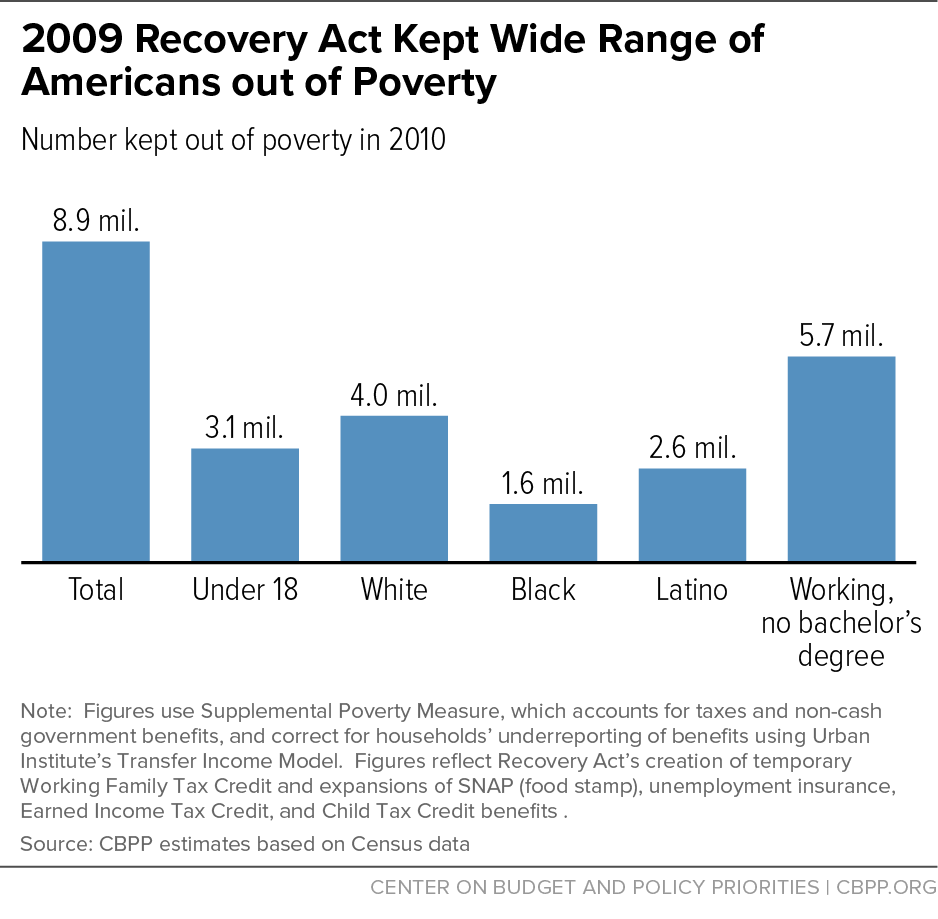BEYOND THE NUMBERS
With President Obama leaving office, it’s worth recalling, with updated data, one of his notable achievements: the 2009 Recovery Act, which helped prevent a historic rise in poverty despite the worst recession since the 1930s. Using newly available data, we estimate that the act, which strengthened key parts of the safety net, kept nearly 9 million Americans from falling below the poverty line and helped hold the poverty rate and the number of poor Americans at essentially their pre-recession levels. Most of those kept out of poverty lived in working families without a college degree.
We examined six parts of the Recovery Act: (1) a temporary boost in SNAP (food stamp) benefits, expansions of the (2) size and (3) duration of unemployment insurance benefits, a (4) sizeable temporary Working Family Tax Credit, and temporary expansions of the (5) Earned Income Tax Credit and (6) Child Tax Credit that later became permanent. Together, they kept 8.9 million people above the poverty line (which was about $25,000 for a typical renter family of four) in 2010. Those 8.9 million people included:
- 3.2 million children under 18;
- 4.1 million white non-Hispanics;
- 1.6 million black non-Hispanics;
- 2.6 million Hispanics; and
- 0.6 million others, from Asian, American Indian, or other backgrounds or multiple races.
Our new estimate exceeds our 2011 estimate that the Recovery Act kept nearly 7 million Americans out of poverty because it reflects newer data from the Urban Institute’s Transfer Income Model (TRIM), which lets us reanalyze the data and mostly correct for households’ underreporting of the benefits they receive. Our new estimate also uses the government’s Supplemental Poverty Measure (SPM), which accounts for taxes and non-cash government benefits — and which wasn’t available when we wrote our 2011 report.
One group that received particular attention in the presidential campaign was non-college working families. People in these families (more precisely, people in families where someone worked during at least part of the year and no one had a bachelor’s degree) comprised a large majority — 5.7 million — of the 8.9 million kept out of poverty, our new analysis shows.
But Recovery Act policies also had a broad reach across the population, helping at least 6 out of 7 Americans in 2010 — due in part to the broadly targeted Making Work Pay Tax Credit — and providing an average of about $1,000 per family.
Those policies also helped stave off a massive surge in poverty. If you don’t count safety net income, the number of people with below-poverty incomes soared by more than 14 million between 2007 and 2010, the most complete data suggest. We don’t have perfectly comparable data for that period that correct for underreporting but, using a similar poverty measure (described here), we calculate that the number of poor remained essentially flat once you fully account for safety net income. The combination of the Recovery Act and the entitlement structure of critical safety net programs like SNAP, which automatically provide benefits to everyone who’s eligible, held the line against poverty in a historic recession.
To be sure, the Great Recession inflicted wrenching disruptions that the national poverty data don’t capture — such as foreclosures, layoffs, loss of savings, and hardships in many communities. But these poverty figures show how much worse things might have been with a weaker government response.

